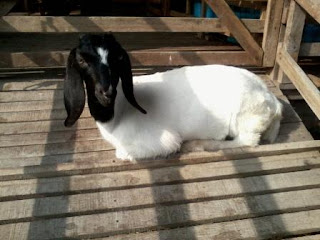Assalamu'alaikum Wrmbth, Banyak ilmu perlu dihadam untuk menjadi
penternak berjaya ya. Ada perumpamaan mengatakan "ilmu adalah seperti
binatang liar dan tulisan adalah tali pengikatnya". "ilmu seperti ikan
yang licin" menunjukkan peri pentingnya proses merekod dan menulis ilmu.
Seingat saya, diriwayatkan Imam Syafie Rahimahumullah mengutip kertas
di jalan untuk menulis apa yang dipelajarinya. Dahsyat betul ulama zaman
silam.
Berbalik pada tajuk, kambing boleh jadi gila jika perkara dibawah berlaku dalam urusan kandang anda:
1. Diberi makan rumput
"brachiaria decumbens" atau RUMPUT SIGNAL.
Rumput apa pula tu? Meh lihat gambarnya dibawah ni. banyak di Malaysia
juga ni. Ingatkan sembarangan rumput boleh beri pada kambing ni ya
rupa2nya ada pengaruh luar sedar juga.
 |
| Rumput brachiaria Decumbens |
 |
| Pembunuh kambing anda dalam diam |
Setelah membuat sedikit kajian diinternet, memang ada disebut tentang keracunan rumput ini pada ternakan
Toxicity
Young
cattle, sheep and goats can develop hepatogenous photosensitization
although prevalence appears to be strongly related to environment. For
example, it is of major concern in Brazil and Papua New Guinea but is
unheard of in Vanuatu and rare in Australia. Transferring stock to
pasture of different species can alleviate symptoms. Photosensitization
in bovines can be avoided by a rotation of 2 weeks on and 2 weeks off
the grass
.
Sporadic outbreaks have been related to mycotoxins from the saprophytic fungus Pithomyces chartarum, but also to saponins.
Photosensitization,
sensitif terhadap cahaya. Mungkin sebab tu dikatakan membawa kegilaan
kerana saya pernah lihat sendiri kambing dikandang saya berlari tak
tentu hala seperti anak ayam hilang ibu. Mungkin sampai ketahap
halusinasi bukan. Siap ada kajian daripada anak tempatan lagitu, kita je
yang tak ambil tau.
1) In South America, different strains of P. chatarum were isolated from Brachiaria pastures where cattle had exhibited toxicity, but no strain had produced sporidesmin (Brewer et al., 1989).
2)
In New Zealand, a high correlation between spore count in the pasture
and toxicity (facial eczema) exists in sheep (Brook, 1969), but this
does not appear to be the case in South America (E. Aycardi, 1994,
personal communication).
3) In
Malaysia, sheep developed photosensitivity when fed hay or fresh signal
grass. However, liver damage was not observed when grass litter,
ideal for fungal growth, was fed (Abas-Mazni and Sharif, 1988).
4)
The pathology of animals poisoned with signal grass is similar to that
found in animals grazing Panicum species not infected with P. chatarum (Graydon et al., 1991).
5) Steroidal saponins were isolated from the rumen contents of poisoned sheep fed signal grass (Lajis et al. 1993; Salam Abdullah et al.
1992). In addition, steroidal saponins were identified in several
plants known to cause photosensitization (Miles et al. 1993), and
the toxicity symptoms were reproduced in sheep through oral dosing
of crude saponins extracted from the plant Tribulus terrestris
(Zygophyllaceae) (Kellerman et al. 1991)" (cited from Lascano and Euclides 1996)
Bagi rujukan lanjut, boleh lawati link dibawah ini
a) http://www.fao.org/ag/AGP/AGPC/doc/Gbase/data/pf000188.htm
b) http://www.tropicalforages.info/key/Forages/Media/Html/Brachiaria_decumbens.htm
2. Diberi
dedak yang telah rosak
dan basi kerana tidak disimpan dengan betul. Dedak tercemar dengan
racun Aflatoxin yang akan memberi kesan sampingan jangka panjang kepada
ternakan kambing anda.
 |
| Kesilapan besar ramai penternak baru, termasuk saya dulu dengan tidak menyimpan dedak seeloknya. |
Ini lah dedak yang elok, dan rangup. Wajib simpan dalam bekas kedap udara. Terima kasih pada alwigoatfarm atas tips dan panduan
Aflatoxins are naturally occurring mycotoxins that are produced by many species of Aspergillus, a fungus, the most notable ones being Aspergillus flavus and Aspergillus parasiticus. Their name is derived from the early work that discovered Aspergillus Flavus toxins. Aflatoxins are toxic and among the most carcinogenic substances known.[1]
After entering the body, aflatoxins may be metabolized by the liver to a
reactive epoxide intermediate or hydroxylated to become the less
harmful aflatoxin M1.
Bahan karsinogen lagi tu, pembawa kanser ni. Kasihan kambing2 aku.
Rujukan
lanjut daripada pakcik Google, rupa2nya aflatoxin ni merosakkan hati
untuk pendedahan jangka panjang dan pada dos tinggi.
Rujukan lanjut boleh copy link dibawah ni.
1. http://en.wikipedia.org/wiki/Aflatoxin
Animals
Aflatoxin
has potential to lead to liver disease in dogs; however, not all dogs
exposed to aflatoxin will develop liver disease. As with any toxic
exposure, development of aflatoxicosis is a dose-related occurrence.
Some dogs that develop liver disease will recover; those exposed to
large doses for extended periods may not.
Low levels of aflatoxin
exposure require continuous consumption for several weeks to months in
order for signs of liver dysfunction to appear.[9]
Some articles have suggested the toxic level in dog food is 100-300
ppb and requires continuous exposure/consumption for a few weeks to
months to develop aflatoxicosis.[10] No information is available to suggest that recovered dogs will later succumb to an aflatoxin-induced disease.
There
is no specific antidote for aflatoxicosis. Symptomatic and supportive
care tailored to the severity of the liver disease may include
intravenous fluids with dextrose, active vitamin K, B vitamins, and a
restricted but high-quality protein diet with adequate carbohydrate
content.













